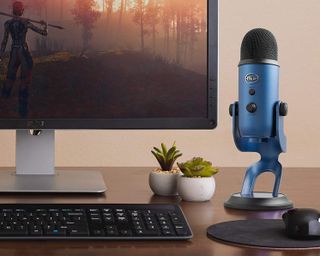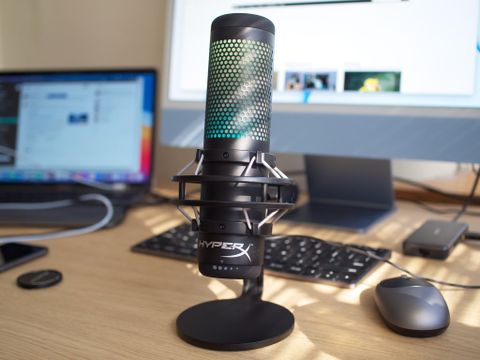iMore Verdict
Bottom line: Even though you can't access every feature with a Mac, the HyperX QuadCast S is a stellar USB microphone that will make you sound better on video calls, recordings, and, yes, while gaming.
Pros
- +
Excellent 48kHz/16-bit sound recording
- +
Built-in pop filter
- +
Four recording patterns
- +
Mute button
- +
Live monitoring through the headphone jack
Cons
- -
Not all features are available on Mac
- -
Can't be removed from the shock mount
You can always trust iMore.
I've used dozens of great USB microphones over the years for multiple purposes. Whether I'm recording my audio for the iMore Show, making a podcast, recording a few things on my acoustic guitar, or just making sure all my coworkers can hear me on video calls, I need a microphone that can work in almost all situations.
I used the HyperX QuadCast S for roughly a month, and I fell in love with it pretty quickly. I mostly have had it hooked up to my blue iMac (2021), but I did give it a test on my PlayStation 4 a few times. Its performance has been stellar, however, there are a few things Mac users should probably be aware of before purchasing.
HyperX QuadCast S: Price and availability

The HyperX QuadCast S is the successor to the HyperX QuadCast and launched in late 2020. It is available at both Amazon and Best Buy for about $160. It ships already assembled, but you can detach the microphone from the stand and put it on any microphone stand with the included adapter.
HyperX QuadCast S: What's great about this microphone

This microphone has handled everything I have thrown at it and has always left me impressed. Although it's primarily billed as a gaming microphone, I recorded podcasts, took video calls, laid down some acoustic guitar and basic vocals using the HyperX QuadCast S, and all of that sounded stellar.
The microphone records 48kHz/16-bit audio and has three 14mm condensers, which provides enough data for post-production if you want to go that route. You can certainly pop this microphone down in front of yourself and tune your voice in lots of different ways in your favorite audio mixing program of your choice. Even though I'm not a talented audio engineer or musician, I was able to lay down a pretty simple acoustic guitar track and then record some vocals and come out with a mix that sounded pretty good. Of course, hardcore musicians are definitely not using a USB microphone to record, but it certainly works for very basic music recording in a pinch.
The four polar patterns offer a lot of versatility
The built-in pop filter is a nice touch, and it really does help cut back on those harsh P, T, and K sounds while recording. However, that thin layer of foam behind the grill isn't perfect. If you like recording super close to your microphone (like within about a foot), you may notice those harsh sounds popping through a little bit. That means whilst recording for singing or music recording, you'll likely still want an additional pop filter on the QuadCast S. Still, for most everyday uses, like gaming, video calls, etc., you'll likely be just fine with the built-in filter.

A big reason for the microphone working in a lot of different situations is the various polar patterns you can record using the QuadCast S. With the simple turn of a knob on the back microphone, you can switch between cardioid, bidirectional, omnidirectional, and stereo polar patterns, making it easy to adjust for your recording needs. I had a few friends over to record a little demo using some of the different modes and was pleasantly surprised at how the QuadCast S performed. Even in the omnidirectional mode, which is notorious for picking up excessive background noise, the voices came through loud and clear sitting in the middle of my friend group.
Background noise isn't too prevalent, but still noticeable
Obviously, adjusting the gain to the correct level for the situation is important, and the HyperX QuadCast S makes that easy. With an adjustable gain knob located at the bottom of the microphone, you can turn it left to increase the gain and right to lower the gain. You can also monitor your recordings live using the headphone jack on the back, so it's easy to hear how you sound and adjust the gain on the way.
The mute button on top of the microphone is also a great feature. It's easy to tap on and off, and although I was a little worried the touch sensor might not always work, it's been flawless for me so far. Plus, when the microphone is muted, the RGB lighting turns off, giving an easily recognizable visual cue to know when the mic is on or not.
Lastly, it looks stunning. I know the RGB lighting is typically associated with the "gamer aesthetic," and some people really don't like it, but I think it's great. The rotating rainbow lighting gives the microphone that extra pizzazz that looks great just sitting on your desk or camera while you're streaming your favorite games.
HyperX QuadCast S: What sucks about this microphone

As much as I have become enamored with this microphone, the QuadCast S has one glaring issue that might be a big deal to you. HyperX's software to control the microphone called Ngenuity is not available on Mac. This means that you can't customize the RGB lighting when using the QuadCast S with your Mac, so you're stuck with the rotating rainbow pattern.
Without Ngenuity, you also can't fool around with the microphone effects HyperX offers through its software. This is less of a big deal since if you're using this mic for work that needs post-production, you likely would be using other software anyway, but it's worth noting that the QuadCast S does have limited functionality on Mac.
HyperX QuadCast S: Competition

As someone who has a Blue Yeti and has used it to record everything, it's probably the best-known direct competition for the QuadCast S. The Yeti has the same four polar patterns, making it just as versatile and records simultaneously audio quality (48kHz/16-bit). Plus, it also has gain control, lives monitoring via a headphone jack and a mute button.
The Blue Yeti is also a bit older, making the price typically a tad more affordable. The price fluctuates around $100 - $130, but we have seen it for as long as $90 before. Of course, it doesn't have RGB lighting, and while the metal construction is sturdy, it's also pretty heavy.
HyperX QuadCast S: Should you buy it?

You should buy this if ...
- Want a USB microphone for various situations
- Like RGB lighting
- Don't mind missing out on a few features
You shouldn't buy this if...
- Don't like the look of the microphone
- You need a professional studio microphone
The HyperX QuadCast S does everything it promises to do. While it certainly is not a studio-grade microphone (no USB microphone really is), it records beautiful clear audio in various scenarios, and the background noise it picks up is pretty manageable. Plus, the built-in pop filter is a welcome addition.
The RGB lighting looks great, and even though you can't take customize the color without the Ngenuity software, the microphone as a whole looks great on your desk or camera.
While it isn't the cheapest microphone out there with most of the same features, the QuadCast S is a solid choice for anyone looking for a USB microphone for their Mac.

Luke Filipowicz has been a writer at iMore, covering Apple for nearly a decade now. He writes a lot about Apple Watch and iPad but covers the iPhone and Mac as well. He often describes himself as an "Apple user on a budget" and firmly believes that great technology can be affordable if you know where to look. Luke also heads up the iMore Show — a weekly podcast focusing on Apple news, rumors, and products but likes to have some fun along the way.
Luke knows he spends more time on Twitter than he probably should, so feel free to follow him or give him a shout on social media @LukeFilipowicz.



